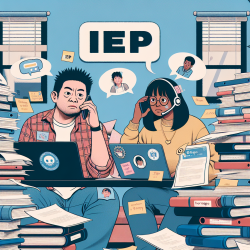Let's face it: IEP meetings can be about as much fun as a root canal without anesthesia. But fear not, parents of children with special needs! TinyEYE is here to help you navigate these meetings with a smile (and maybe even a laugh or two).
First things first, let's talk about what an IEP (Individualized Education Program) actually is. Think of it as a personalized roadmap designed to help your child succeed in school. It includes goals, services, and accommodations tailored specifically to your child's needs. Sounds great, right? But getting there can sometimes feel like climbing Mount Everest in flip-flops.
Preparation is Key
Before you even step foot in that meeting room (or log into the virtual meeting, thanks to telehealth), make sure you're prepared. Here's a handy checklist to get you started:
- Know Your Child's Strengths and Weaknesses: Make a list of your child's abilities and challenges. This will help you advocate more effectively.
- Gather Documentation: Bring any relevant reports, evaluations, and notes from teachers or therapists.
- Write Down Your Concerns and Goals: What do you want to see your child achieve? Having a clear list will help keep the meeting focused.
- Understand the Terminology: Educators love their acronyms. Familiarize yourself with terms like FAPE (Free Appropriate Public Education) and LRE (Least Restrictive Environment).
The Meeting Itself
Okay, you've prepped like a pro. Now it's time for the main event. Here are some tips to help you keep your cool:
- Bring a Buddy: If possible, bring a friend, family member, or advocate. Two heads are better than one, and it's always nice to have moral support.
- Stay Positive: Remember, everyone in the room wants to help your child succeed. Keep the conversation constructive and focused on solutions.
- Ask Questions: If something isn't clear, don't be afraid to ask for clarification. There's no such thing as a dumb question in an IEP meeting.
- Take Breaks if Needed: These meetings can be long and emotionally draining. Don't hesitate to ask for a short break if you need to regroup.
After the Meeting
Once the meeting is over, take a deep breath. You've made it through! But the work doesn't stop there. Here's what to do next:
- Review the IEP Document: Make sure everything discussed is accurately reflected in the document. If something is missing or incorrect, request a revision.
- Communicate with Your Child: Explain the plan to your child in a way they can understand. Let them know what to expect and how they can work towards their goals.
- Stay Involved: Keep in regular contact with your child's teachers and therapists. Monitor progress and make adjustments as needed.
And there you have it! With a little preparation, a positive attitude, and a sense of humor, you can turn IEP meetings from a dreaded chore into a productive and even enjoyable experience. Remember, TinyEYE is here to support you every step of the way with our online therapy services. Whether it's speech therapy staffing or telehealth solutions, we've got you covered.
So go ahead, take a deep breath, and tackle that IEP meeting with confidence. You've got this!










